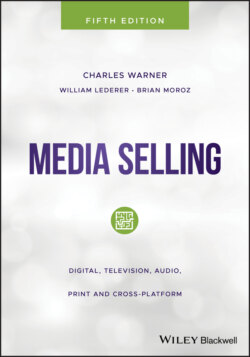Читать книгу Media Selling - Warner Charles Dudley - Страница 41
Some definitions
ОглавлениеFollowing are some definitions that will clarify the concepts of selling as serving and clients as partners:
Buyers are divided into three types: prospects, customers, and partners.Prospects are people who have not bought a product for a variety of reasons, ranging from never having heard of it to disliking it; prospects require missionary selling. In the media, prospects might be those people who: (1) have never before advertised because they have an established business that they feel does not need advertising; (2) have never advertised before because they are starting a new business; (3) advertise but not in your medium; or (4) advertise in your medium but do not use your platform, website, mobile app, network, station, newspaper, cable system, or magazine.Customers are people who have either decided to buy a product or who have already bought a product and are going to buy it again. Customers require outrageous service that will delight them and make them “raving fans.”16Partners are customers who have collaborated with a media company to conduct business based on mutual trust and, in a sense, to help each other to be more successful by cooperating in discovering innovative solutions that connect a partner to a medium’s audience in a way that delivers partner‐defined results and jointly builds the business of both companies.
Investments are advertising dollars placed in the media. In the past advertising money has been “spent” in the media; however, many marketers and their advertising and media agencies have realized that advertising is an investment in future sales of a product. Major media agencies promote the concept of advertising as an investment. For example, WPP’s media agency Group M refers to itself as “the world’s largest investment group.”17 Media salespeople should always refer to advertising as an investment. Thus, rather than asking a prospect, “How much money do you spend in advertising?” ask, “How much money do you invest in advertising?” It is important for media salespeople to educate marketers about the fact that their advertising is an investment.
Products are either tangible or intangible. Tangible products are goods that can be seen and touched, such as automobiles, personal computers, or cosmetics. Intangible products are services that cannot be seen, touched, or tested in advance, such as insurance, financial services, or advertising. Tangible products can be experienced and they are usually easy to demonstrate – product features and benefits are apparent before a purchase. However, even tangible products have some degree of intangibility, as pointed out by Theodore Levitt, “You can't taste in advance or even see sardines in a can or soap in a box. This is common for frequently purchased moderate‐ to low‐priced consumer goods. To make buyers more comfortable and confident about tangibles that can’t be pre‐tested, companies go beyond the literal promises of specifications, advertisements, and labels to provide reassurance.”18
Packaging is one common tool used to make the intangible elements of products more tangible in a consumer's mind – for example, putting pickles in a glass jar so purchasers can see them. Advertising is another tool used to communicate advance assurances that a product is what it says it is.
It is harder to keep customers satisfied with intangible products than with tangible ones. The biggest problem with intangible services – such as advertising, insurance, or banking services – is that customers are usually not aware of the full range of services they are getting until they no longer get them. Therefore, they rarely appreciate the positives, and the negatives tend to be blown out of proportion. This situation means that intangibles require more service and greater efforts on the part of salespeople. From now on all products and services will be referred to as products, whether they are tangible or intangible.
